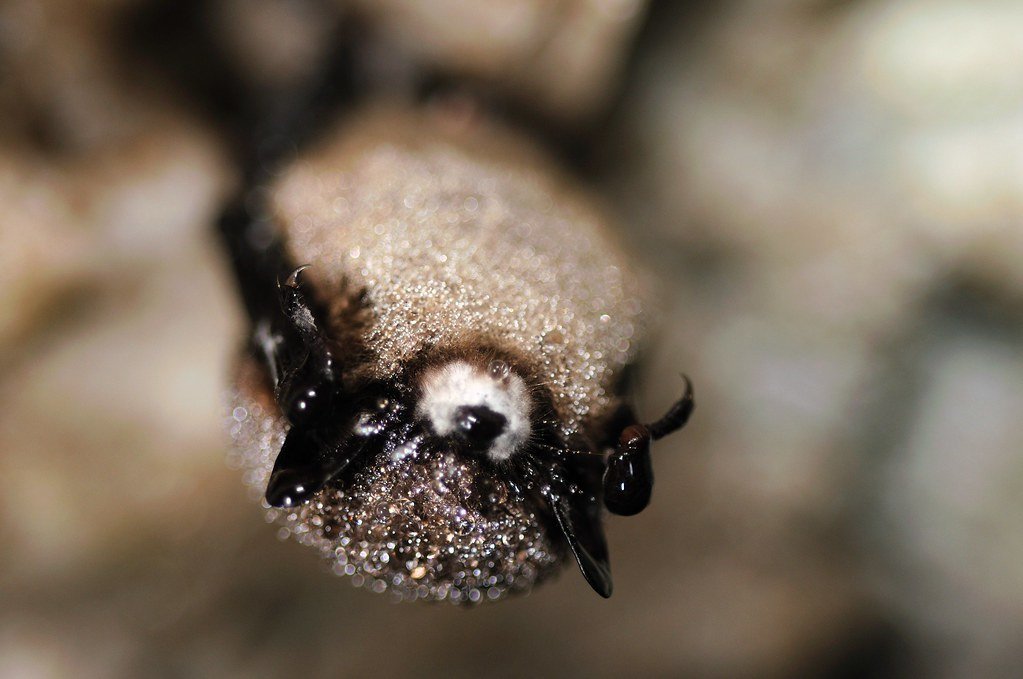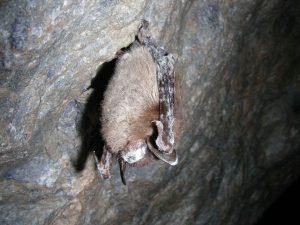White Nose Syndrome (WNS)

What Is White Nose Syndrome?
White-nose syndrome is an evolving disease of hibernating bats that is rapidly spreading from the northeast to the center of the United States. This devastating disease has killed millions of insect-eating bats in at least 33 states and seven Canadian provinces since the winter of 2007-2008. The disease is named after the white fungus Pseudogymnoascus destructans, which infects the skin of hibernating bats’ muzzle, ears, and wings. The fungus that causes WNS thrives in the cold and humid conditions found in bat caves and mines.
White-nose Syndrome is believed to be transmitted primarily from bat to bat, according to scientists. It’s also possible that it’s spread by humans inadvertently carrying the fungus on their clothing and equipment from cave to cave.
White-nose Syndrome affects bats in various ways, including abnormal behavior both inside and outside the cave where they hibernate during the winter. 1Go To Source usgs.gov -“What is White-nose Syndrome?”
Learn More: Common Wildlife Viruses
What Species Are Prone To White Nose Syndrome?
The WNS disease has affected thirteen species, three of which are on the federal endangered species list. White-nose syndrome has been found in the following species:
- Little Brown Bat
- Northern Long-eared Bat
- Tricolored Bat
- Indiana Bat
- The Big Brown Bat
- Eastern Small-footed Bat
- Gray Bat 2Go To Source biologicaldiversity.org -“WHITE-NOSE SYNDROME: QUESTIONS AND ANSWERS”
How Is White Nose Syndrome Spread?

The fungus that causes WNS can be spread in a variety of ways. Bats can contract the fungus from infected bats through physical contact. Bats can also pick up the fungus from the cave or mine walls where they’re hibernating.
Humans carry the fungus on their shoes, clothing, or gear after entering a bat’s roosting area. As a result, it’s critical not to bring clothing or equipment from a WNS-affected site into a WNS-free site. As a result, properly removing the fungus from your gear and shoes before and after entering caves or attics is critical. 3Go To Source nps.gov -“What Is White-nose Syndrome?”
Are Humans Or Pets Affected By White Nose Syndrome?
Since White-nose Syndrome (WNS) was first discovered, thousands of people have visited affected caves and mines, but no human illnesses have been linked to WNS. We’re still learning about WNS, but contact with WNS-affected bats poses no risk to humans. However, its recommend that you take precautions and avoid being exposed to WNS. When entering caves or handling bats, biologists and researchers should wear protective clothing. 4Go To Source fs.usda.gov -“White-Nose Syndrome”
Pets also seem to be unaffected by white-nose syndrome. Problems occur when bats die from the illness, and a pet comes into contact with them. Other bacteria and diseases contained in the bat may be exposed to your pets in this situation.
What Are The Visual Signs Of White Nose Syndrome?
A major sign of WNS is bats acting strangely in the winter. Bats may be found clustered near hibernacula entrances or flying outside during the day when temperatures are below freezing(when you should be inside). Other locations may have groups of dead or dying bats. The white fungus may also be visible on the snout of the bats.
Loss of fluids, starvation, or loss of electrolytes across damaged wing membranes is thought to be the causes of WNS death in bats. Because of the fungus, which burns vital fat reserves, they arouse more frequently and earlier than usual while hibernating. During the winter, they may leave their hibernacula in search of food. 5Go To Source cwhl.vet.cornell.edu -“White Nose Syndrome”
Is White Nose Syndrome Dangerous?

In most cases, the disease kills 70% to 90% of bats in an infected hibernaculum (the area where bats gather to hibernate for the winter). The mortality rate has been as high as 100% in some cases, wiping out entire colonies. Hundreds of thousands of bats once inhabited caves that are now nearly deserted. According to the US Fish and Wildlife Service, 6.7 million bats died in North America in 2012. Since that estimate, many more bats have died.
WNS does not affect humans, but visitors to caves may unintentionally spread the fungus from cave to cave because it can linger on clothing and equipment. Many caves have been closed to recreational visits to protect hibernating bat populations.
How To Prevent White Nose Syndrome?
White-nose syndrome is found wherever bats roost, including caves and attics. When handling bats people should follow these guidelines:
- Avoid contact with these pests at all times.
- If you must be near bats, wear masks and full-length clothing.
- Dispose of any clothing that has touched a bat or its droppings.
- Contact a wildlife removal professional if you have bats in the attic.
- Make sure the animal removal service you contacted also removes all dropping and urine left behind.
How To Safely Remove Bats With WNS?
Removing bats from the attic is a tricky task because federal law protects bats from being trapped. Animal removal technicians remove bats through “exclusion,” which involves sealing a building except for primary exits, which are equipped with one-way doors that allow bats to exit while preventing re-entry. Once the attic is empty of bats, a wildlife professional will conduct a decontamination process to eliminate any bacteria left behind in urine or feces. Attempting the removal or clean-up on your own may result in bats still living in the attic or the contraction of diseases from contact with bat droppings.
Sources:
- “What Is White-Nose Syndrome?” USGS Science For A Changing World, U.S. Department Of The Interior, www.usgs.gov/faqs/what-white-nose-syndrome?qt-news_science_products=0#qt-news_science_products. Accessed 22 Mar. 2021.
- “White-Nose Syndrome: Questions and Answers.” Center For Biological Diversity, The Center for Biological Diversity, www.biologicaldiversity.org/campaigns/bat_crisis_white-nose_syndrome/Q_and_A.html#:%7E:text=The%20following%20species%20have%20been,and%20gray%20bat%20(endangered). Accessed 22 Mar. 2021.
- NPS. “What Is White-Nose Syndrome? (U.S. National Park Service).” National Park Service, U.S. Department Of The Interior, 8 Dec. 2017, www.nps.gov/articles/what-is-white-nose-syndrome.htm.
- “White-Nose Syndrome.” Forest Service U.S. Department Of Agriculture, www.fs.usda.gov/Internet/FSE_DOCUMENTS/fseprd501625.pdf. Accessed 22 Mar. 2021.
- “White Nose Syndrome.” Cornell Wildlife Health Lab, Cornell University, cwhl.vet.cornell.edu/disease/white-nose-syndrome#collapse5. Accessed 22 Mar. 2021.
